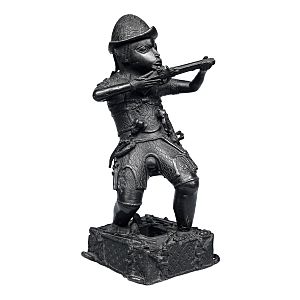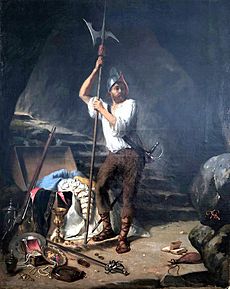Morion (helmet) facts for kids
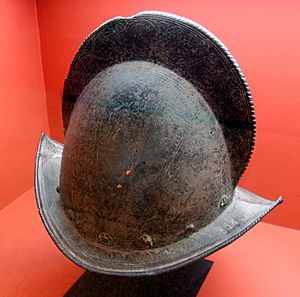
A morion (in Spanish: morrión) is a type of open-faced combat helmet. It came from the Kingdom of Castile (Spain). People used it from the early 1500s to the early 1600s. This helmet usually had a flat brim and a crest, or raised part, from front to back. It became popular when explorers like Hernando de Soto and Coronado were exploring North, Central, and South America in the 1540s. They likely gave these helmets to their foot soldiers.
Contents
History of the Morion Helmet
The morion helmet is often linked to early Spanish explorers and conquistadors. However, it was not widely used until after Hernán Cortés conquered Mexico. It also became popular after Francisco Pizarro conquered the Incas in South America. The Spanish used it a lot. But about 30 to 40 years later, soldiers from many other European countries also wore it.
It was cheap to make, which helped it become very popular. Officers and special guards often had their helmets decorated with fancy designs. This showed their wealth and importance.
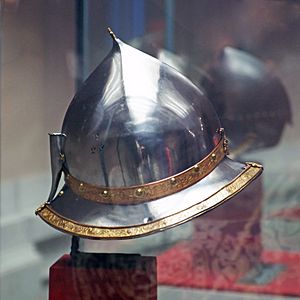
The crest or comb on top of the helmet made it stronger. Later versions also had pieces to protect the cheeks. Some even had removable faceplates to keep soldiers safe from sword cuts.
The morion's shape came from an older Spanish helmet. This helmet was called a kettle hat or capacete in the 1400s. The word "morion" likely comes from the Spanish word morrión. This word is related to morro, meaning "round object." The Royal Spanish Academy says morrión comes from morra, which means "the top part of the head."
The Morion in England
In England, this helmet was also known as the pikeman's pot. It is connected to the New Model Army, which was one of the first professional armies. Pikemen wore it along with a breastplate and a buff coat. They stood in tight groups, like a phalanx, protecting soldiers with guns. These gun-carrying soldiers, called musketeers, did not wear armor.
Italian armor makers were hired to make helmets for the English army. This is why some English morions look similar to Italian designs.
The helmet helped protect soldiers during "push of pike" fights. These fights often caused many injuries and deaths. Most of Oliver Cromwell's Parliamentarian soldiers wore the morion. But many Cavaliers, who fought for the King, also wore it. This caused confusion during battles. Soldiers risked being shot by their own side.
Because of this, armies started using uniforms to tell soldiers apart. At first, these were simple colored sashes. Soon, the Roundheads began wearing red coats. The army kept these red coats even after Charles II became King again in 1660.
Morions from the 1648 Siege of Colchester have been found. They are now kept at Colchester Castle. A lobster tail pot, another type of helmet, was also found there. This helmet is linked to Cromwell's heavily armored Ironside cavalry.
Morions Around the World
Some Spanish armor was captured and worn by Native Americans. They wore it as late as the 1800s. It protected them from bullets and showed their high status. The most famous example was Comanche chief Iron Jacket. He lived in Texas and wore armor that once belonged to a Spanish conquistador.
In the Philippines, the native Moro people copied the morion and burgonet helmet designs. They also used chainmail and horn coats. They did this during the Spanish–Moro Wars and the Moro Rebellion. The helmets they made were usually of iron or brass. They were decorated with fancy flower patterns, often in silver. These helmets had a large visor and neck guard. They also had movable cheek guards, a high crest, and three very tall feathered plumes. These plumes could be as long as 60 cm (24 in). The Moro versions of the morion were actually more like the burgonet helmet.
The Cabasset Helmet
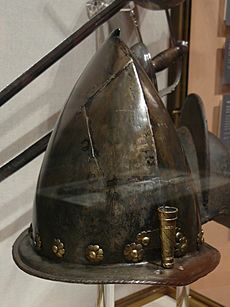
A helmet similar to the morion is the cabasset (in Spanish: capacete). It was also worn in the 1500s and came from Spain. It's not clear if it came before the morion or was a changed version of it. Some sources say it was a more modern helmet. The word "cabasset" probably comes from the Spanish word cabeza (head). But some people think it comes from an Italian word for "pear". This is because the helmet had a small part on top that looked like a pear stalk.
These helmets were mostly made in Calatayud, a town in Aragon. Like morions, foot soldiers wore them in "pike and shot" formations. The cabasset was popular in 1500s England. It was also used during the Civil War. The Pilgrim fathers took several of these helmets to the New World. One has been found on Jamestown Island.
Morions in Modern Times
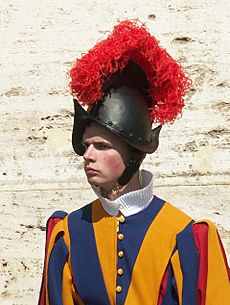
- Pith helmets came about when the Spanish changed the Philippine salakot helmet. They shaped it to look like morions or cabassets.
- The morion might have influenced the design of the Adrian Helmet. French and Italian soldiers wore this helmet during World War I. Both helmets have a similar shape and a comb on top to make them stronger.
- The comb morion, with a red crest, is part of the uniform for the Pope's Swiss Guard. A Swiss guard wearing his morion is shown on the Vatican City special two-euro coin.
- From 1928 to 1961, the morion was the logo for the car company DeSoto. The company was named after the explorer Hernando de Soto. The morion appeared as a decoration on the front of DeSoto cars in the 1940s and 1950s.
- The official symbol of Cupertino, California, includes a morion.
- The morion is on the symbol of the 53rd Infantry Brigade Combat Team. This is the largest group in the Florida Army National Guard. It honors the early militias of Florida when it was under Spanish rule.
See also
- Burgonet
- Sallet
- Paseki, a copy of morion from Indonesia
- Pith helmet


